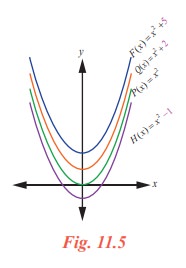Definition, Theorem - Newton Leibnitz Integral | 11th Mathematics : UNIT 11 : Integral Calculus
Chapter: 11th Mathematics : UNIT 11 : Integral Calculus
Newton Leibnitz Integral
Newton-Leibnitz Integral
Integral calculus is mainly divided into indefinite integrals and definite integrals. In this chapter, we study indefinite integration, the process of obtaining a function from its derivative.
We are already familiar with inverse operations. (+,-) (x,÷), ()n,n√ are some pairs of inverse operations. Similarly differentiation and integrations (d, ∫ ) are also inverse operations. In this section we develop the inverse operation of differentiation called ‘antidifferentiation’.

Definition 11.1
A function F (x) is called an antiderivative (Newton-Leibnitz integral or primitive) of a function f (x) on an interval I if
F ′(x ) = f (x) , for every value of x in I
Illustration 11.1
If F (x ) = x2 + 5 then
F ′(x ) = 2x .
Thus if f (x) is defined by

f( x ) = 2x, then
we say that f (x) is the derivative of F (x) and that F (x) is an antiderivative of f (x)
Consider the following table

We can see that the derivative of F (x) , P (x) , Q (x) and H (x) is f (x) , but in reverse the antiderivatives of f (x ) = 2x is not unique. That is the antiderivatives of f (x) is a family of infinitely many functions.
Theorem 11.1
If F (x) is a particular antiderivative of a function f (x) on an interval I, then every antiderivative of f (x) on I is given by
∫ f ( x)dx = F ( x) + c
where c is called an arbitrary constant, and all antiderivatives of f (x) on I can be obtained by assigning particular value to c.
The function f(x) is called Integrand.
The variable x in dx is called variable of integration or integrator.
The process of finding the integral is called integration or antidifferentiation (Newton-Leibnitz integral).
The peculiar integral sign ∫ originates in an elongated S (like Σ ) which stands for sum.
Often in applications involving differentiation it is desired to find a particular integral antiderivative that satisfies certain conditions called initial condition or boundary conditions.
For instance, if an equation involving dy/dx is given as well as the initial condition that y = y1 when x = x1, then after the set of all antiderivatives is found, if x and y are replaced by x1 and y1 , a particular value of the arbitrary constant is determined. With this value of c a particular antiderivative is obtained.
Illustration 11.2
Suppose we wish to find the particular antiderivative satisfying the equation

and the initial condition that y = 10 when x = 2.
From the given equation

We substitute y = 10 when x = 2 , in the above equation
10 = 22 + c ⇒ c = 6
When this value c =6 is substituted we obtain
= x2 + 6
which gives the particular antiderivative desired.
Related Topics